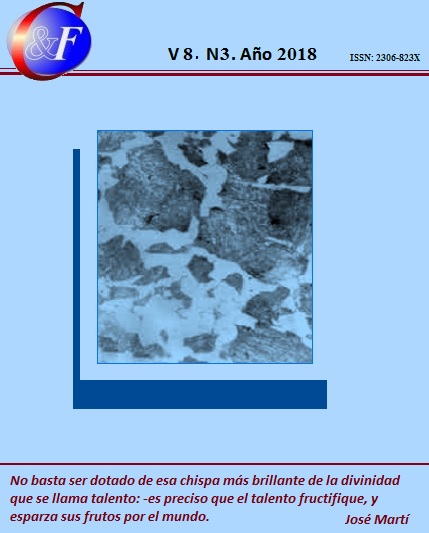Variations microstructural of a steel exposed micro alloyed to high temperatures
Keywords:
admission valve, escape valve, microstructure, offspringAbstract
The variations microestructurales of a steel micro alloy used in the production of the admission valves and escape of an engine of internal combustion is analyzed, which have suffered transformation due to the work temperature. For this analysis a valve was selected without being exposed to work conditions and valves (one of admission and another of escape) retreat of service that they were cut in different parts like in the head of the valve, the inferior part and superior of the offspring, as well as the centre of the same one. It was determined that it stops 400 oC, temperature of work of the admission valve, transformation of phases it doesn't exist in the steel and although the escape valve should work to 700 oC, it exists transformations in the structure that predicts that, for the deformations in the crystalline net, this temperature is above the 850 oC for the presence of the martensite and the sorbit, with an increment of the hardness of up to 450 HV in the retired offspring of service.Downloads
References
ARÁUJO, J. & NOWELL, D. 2002. The effect of rapidly varying contact stress fields on fretting fatigue. International Journal of Fatigue 24(7): 763-775.
CALLISTER, W. 2000. Materials Science and Engineering. An Introduction. Fifth Ed. John Wiley & Sons, Inc., 8195 p.
CHUNGEN, Z. 1999. Deposition of aluminise and chromium–modified aluminise coatings on TiAl alloys using the allied activate pack cementation method. Chinese Journal of Aeronautics 12(1): 24-32.
DINDA, S. & KUJAWSKI, D. 2004. Correlation and prediction of fatigue crack growth for different ratios using parameters. Engineering Fracture Mechanics 71(12): 1779-1790.
GULIAEV, A. 1983. Metalografía. Tomo 2. Editorial Mir, Moscú.
HUSSAINOVA, I. & SCHADE, K. 2008. Correlation between solid particle erosion of cermets and particle impact dynamics. Tribology International 41(14): 323-330.
JOHANSSON, B. & OLSSON, A. 2000. Current design practice and research on stainless steel structures in Sweden. Journal of Constructional Research 54(21): 3-29.
MORENO, F.; WILMAN, J.; SALAZAR, C. & LAURA, A. 2005. Evaluación del comportamiento mecánico a la fatiga en aceros
AISI 4340 y AISI 4140 tratados térmicamente con recocidos y normalizados. Revista Ingeniería UC 12(1): 40-45.
SMITH, K.; WATSON; P. & TOPPER, T. 1970. A stress-strain functions for the fatigue of metals. Journal of Materials 5(4): 767-778.
ZHANG, M.; KELLY, P. & GATES, J. 2003. The effect of heat treatment on the toughness, hardness and microstructure of low carbon white cast irons. Journal of Materials Science 36(15): 3865-3875.
Published
How to Cite
Issue
Section
Esta obra está bajo una Licencia Creative Commons Reconocimiento-NoComercial 4.0 Internacional
La Revista Ciencia & Futuro es una revista de acceso abierto, todo el contenido está disponible gratuitamente sin cargo para el usuario o su institución. Los usuarios pueden leer, descargar, copiar, distribuir, imprimir, buscar o vincular los textos completos de los artículos, o utilizarlos para cualquier otro fin lícito, sin pedir permiso previo al editor o al autor. Todo lo anterior, de acuerdo con la definición de BOAI de acceso abierto.
Los autores que publican en esta revista están de acuerdo con los siguientes términos: Licencia Creative Commons Atribución-NoComercial permite que el beneficiario de la licencia tenga el derecho de copiar, distribuir, exhibir y representar la obra y hacer obras derivadas para fines no comerciales siempre y cuando reconozca y cite la obra de la forma especificada por el autor o el licenciante. Los autores pueden establecer por separado acuerdos adicionales para la distribución no exclusiva de la versión de la obra publicada en la revista (por ejemplo, situarlo en un repositorio institucional o publicarlo en un libro), con un reconocimiento de su publicación inicial en esta revista. Se permite y se anima a los autores a difundir sus trabajos electrónicamente (por ejemplo, en repositorios institucionales o en su propio sitio web) antes y durante el proceso de envío, ya que puede dar lugar a intercambios productivos, así como a una citación más temprana y mayor de los trabajos publicados (Véase The Effect of Open Access) (en inglés). Lo anterior debe realizarse siempre sobre el artículo ya publicado por Ciencia & Futuro.
Los autores mantienen el control sobre la integridad de sus trabajos y el derecho a ser adecuadamente reconocidos y citados.
A los editores se les otorgan derechos no exclusivos para publicar y distribuir.



